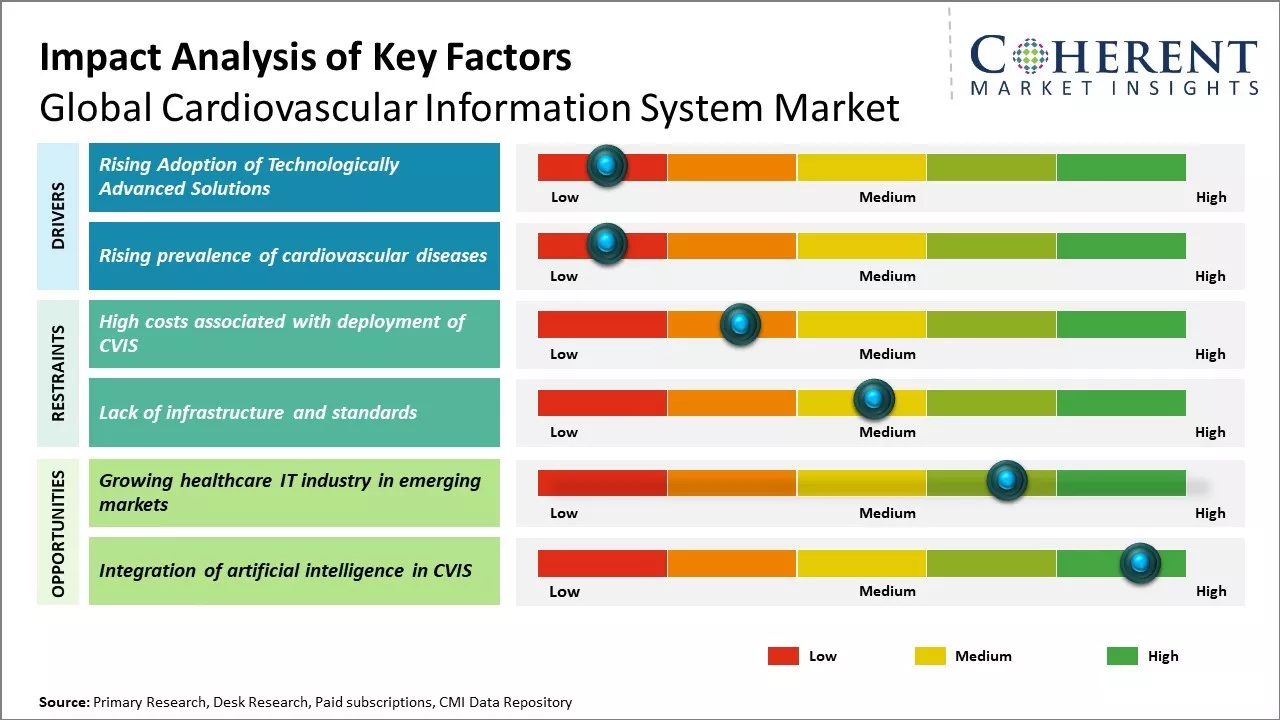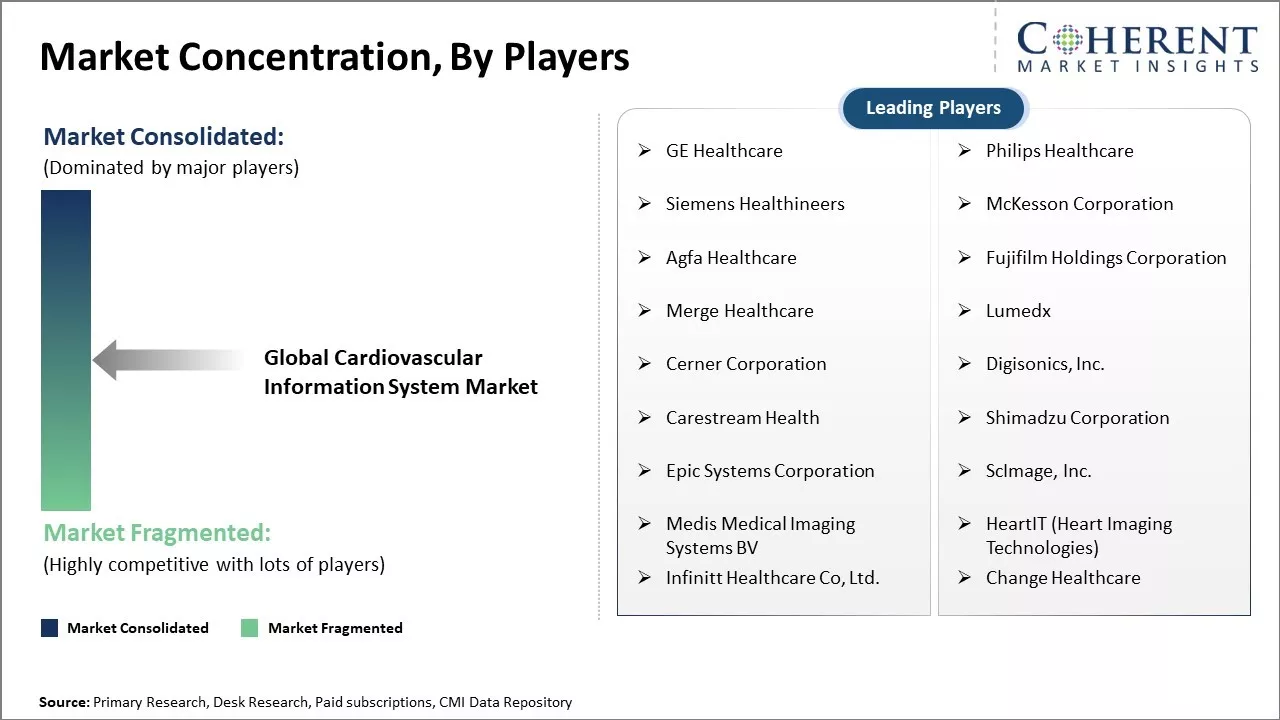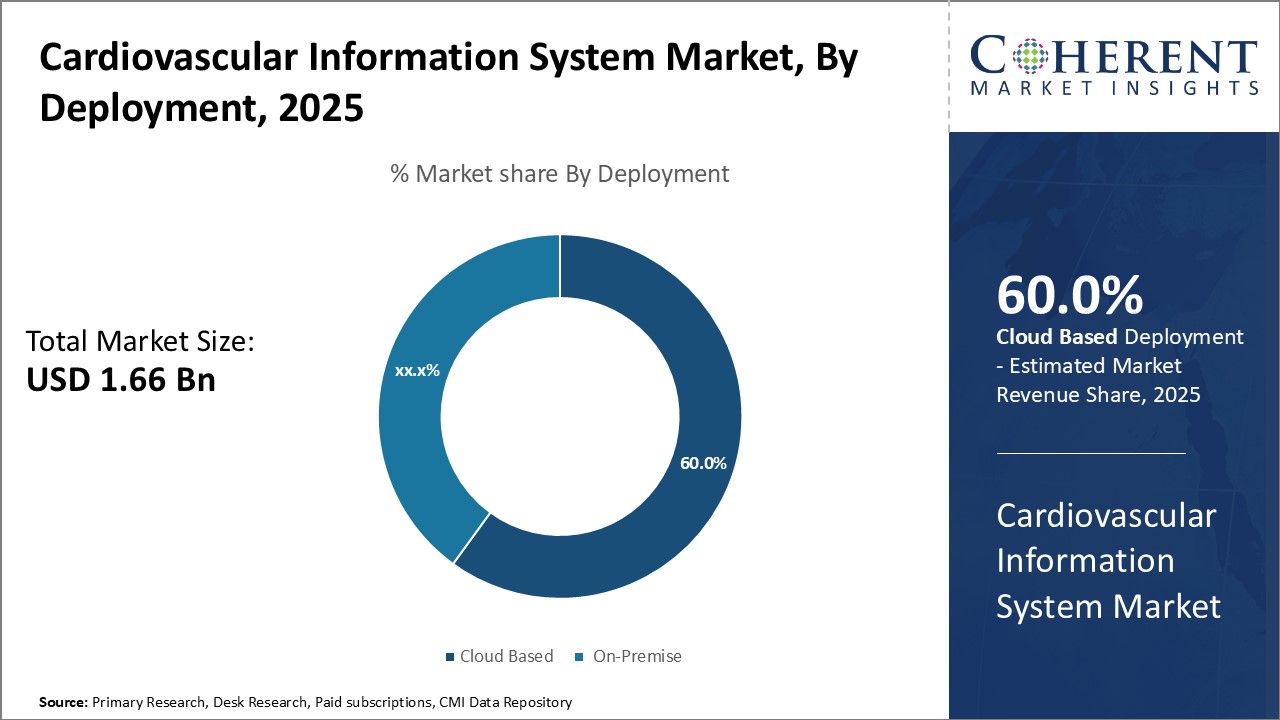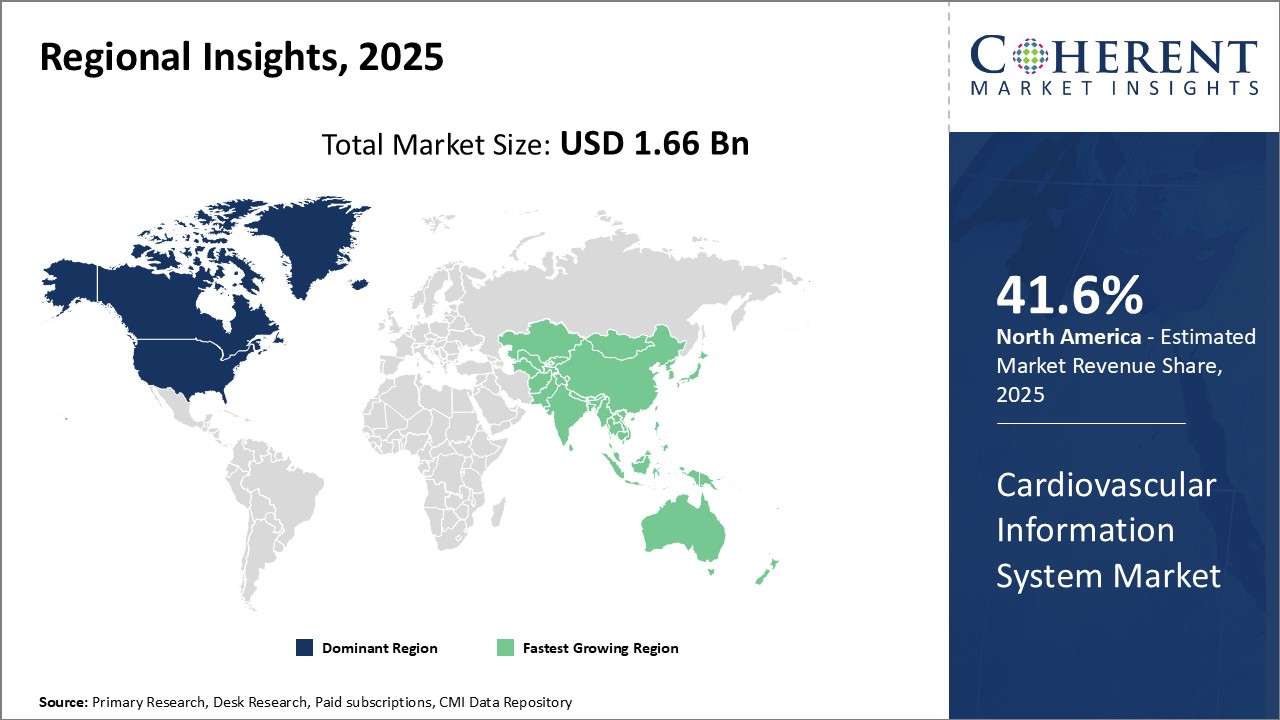The global cardiovascular information system market is estimated to be valued at USD 1.66 Bn in 2025 and is expected to reach USD 3.17 Bn by 2032, exhibiting a compound annual growth rate (CAGR) of 9.5% from 2025 to 2032.

Discover market dynamics shaping the industry: Request sample copy
The cardiovascular information system market is driven by the increasing prevalence of cardiovascular diseases and growing adoption of advanced technologies among healthcare providers. Rising geriatric population which is more prone to develop heart diseases and implementation of government initiatives to create awareness about heart health have also augmented the demand for cardiovascular information systems. Additionally, increasing investments by key players to develop more innovative and integrated solutions will further aid the market growth over the forecast period. However, high installation costs associated with these systems may hamper the cardiovascular information system market growth to some extent.
Rising Adoption of Technologically Advanced Solutions
The cardiovascular information system market is witnessing significant transformation driven by the incorporation of advanced technologies. With healthcare now transitioning from fee-for-service to value-based care, there is growing emphasis on optimizing clinical workflows, improving patient outcomes as well as lowering healthcare costs. This has accelerated the adoption of technologically advanced cardiovascular information systems that facilitate more informed clinical decision making and comprehensive patient management. Various leading hospitals and healthcare organizations are implementing digital cardiovascular solutions to modernize cardiology operations, enhance collaboration between departments, and streamline critical processes like result reporting. Advanced systems featuring integrated imaging and analytics capabilities are playing a pivotal role in personalized care planning and facilitating a seamless multidisciplinary approach. Modules that aggregate siloed data from disparate sources allow physicians to gain a holistic view of patient profiles which aids in the timely diagnosis and selection of appropriate treatment pathways. Cloud-based platforms further enable the ubiquitous viewing of cardiac records and remote monitoring of high-risk cases. The COVID-19 pandemic has moreover highlighted the need for virtual care delivery models. Many providers are turning to digital cardiovascular platforms that facilitate telecardiology services and remote patient monitoring to address staff shortage issues and reduce physical visits.

Get actionable strategies to beat competition: Request sample copy
Rising prevalence of cardiovascular diseases
The rising prevalence of cardiovascular diseases worldwide is posing a serious public health challenge and is a key factor driving the growth of the global cardiovascular information system market. Cardiovascular diseases are the leading cause of deaths globally, accounting for over 17.9 million lives lost each year according to the World Health Organization. The occurrences of conditions like coronary heart disease, stroke, heart attack, and heart failure are steadily increasing. For instance, as per the American Heart Association's Heart Disease and Stroke Statistics report in 2022, coronary heart disease causes around 366,800 deaths in the U.S. each year making it one of the most common causes of mortality. Cardiovascular information systems are becoming increasingly vital for healthcare institutions to better manage these complex conditions and improve patient outcomes. They help in the seamless collection, storage and integration of cardiovascular patient data from various diagnostic sources like ECGs, Holter monitors, echocardiograms, and other cardiac tests. This centralized clinical data repository enables improved clinical decision making, streamlined workflow efficiency, and inter-departmental communication. For instance, according to American Heart Association, Inc., on June 4, 2024, by 2050, it is projected that over 184 million people in the U.S., which exceeds 61% of the population, will suffer from some form of cardiovascular disease (CVD). This significant increase is attributed to demographic shifts, particularly an older and more diverse population, coupled with rising risk factors like high blood pressure and obesity. According to projections from the American Heart Association, the total costs related to cardiovascular conditions are expected to triple, reaching a staggering US$ 1.8 trillion by 2050. These costs encompass both direct medical expenses and indirect costs related to lost productivity and other economic impacts. These projections were highlighted in recent presidential advisories from the American Heart Association, underscoring the urgent need for enhanced preventive measures and interventions to mitigate the growing burden of cardiovascular disease in the coming decades.
Key Takeaways from Analyst:
The global cardiovascular information system market is poised to grow substantially in the coming years. The rising geriatric population prone to cardiovascular diseases, and the growing need for improved patient outcomes and reduced healthcare costs are the major drivers augmenting the demand for cardiovascular information systems. However, high costs associated with installation, maintenance and upgrades of these systems may hinder the market growth to some extent.
North America presently dominates the global market owing to technological advancements, availability of funds for research, well-established healthcare infrastructure, and higher adoption rates among healthcare providers in the region. Asia Pacific is expected to be the fastest growing market led by counties like China and India. This can be attributed to increasing healthcare expenditure, growing incidence of cardiovascular disorders, rising medical tourism, and improving regulatory environment in emerging Asian countries.
The market players must focus on developing holistic cardiovascular information solutions which offer the seamless integration of various cardiology modules. They should also explore opportunities in developing markets to leverage high growth potentials. Partnerships with healthcare providers and healthcare IT companies provides an opportunity for market players to expand their client base and offerings. The adoption of cloud-based solutions is another area that offers significant growth prospects in the coming years.
Market Challenges: High costs associated with deployment of CVIS
The high costs associated with deploying cardiovascular information systems (CVIS) poses a major challenge for the growth of the global CVIS market. Implementing a CVIS requires a significant upfront capital investment and ongoing operational expenses. This makes CVIS unviable for smaller hospitals and clinics that have constrained budgets. Setting up a basic CVIS system involves purchasing expensive software licenses, server hardware, data storage infrastructure, networking equipment, implementation, and integration services. It is estimated that the average cost of deploying a basic CVIS ranges between $500,000 to $1 million. Additionally, hospitals have to budget for annual software license renewal fees, hardware maintenance contracts, regular system upgrades, staff training costs, and technical support expenses to ensure the smooth operation of the CVIS.
Market Opportunities: Growing healthcare IT industry in emerging markets
The growing healthcare IT industry in emerging markets such as India, China, and Southeast Asia presents a great opportunity for the global cardiovascular information system market. As economies in these regions are developing rapidly, governments are investing heavily in modernizing their healthcare infrastructure and digitizing patient medical records. This aims to not only improve access and quality of care for their huge populations but also make important healthcare data available seamlessly to doctors and hospitals. Cardiovascular information systems, which enable the electronic filing and retrieval of cardiology department reports such as echocardiograms, cardiac catheterizations and treadmill tests, are well-positioned to benefit from this healthcare technology transformation. Hospitals and clinics in emerging nations that are either new or upgrading themselves are more likely to install integrated digital cardiovascular systems from the start, rather than relying on outdated paper-based recordkeeping. This growing demand from healthcare facilities catering to the massive underserved populations will be the key driver of expansion for global CVIS vendors over the next few years.

Discover high revenue pocket segments and roadmap to it: Request sample copy
Insights By Deployment: Technological Advancements and Increased Scalability Drive Growth in the Cloud Based Segment
In terms of deployment, cloud based is expected to contribute the highest share of the market with 59.45 % in 2025 owing to technological advancements and increased scalability driving its adoption. Cloud technology has seen tremendous innovation in recent years, with improvements in virtualization, automation, and hosting infrastructure, making cloud platforms far more reliable and flexible than traditional on-premise systems. Healthcare providers can now leverage cloud-based cardiovascular information systems to gain insights from massive datasets and integrate disparate sources of health data more seamlessly. The ability of cloud platforms to horizontally and vertically scale computational resources on demand allows cardiovascular departments and clinics of all sizes to optimize hardware expenses. By avoiding large upfront capital costs for servers and ongoing maintenance, the pay-as-you-go model of cloud computing significantly lowers the financial barrier to entry for advanced cardiac data management capabilities. Additionally, cloud deployment simplifies system updates, allowing new features and bug fixes to be rolled out seamlessly across all client workstations via the internet. This streamlines compliance with changing regulatory standards and facilitates collaborative care models involving multiple specialists. As cloud infrastructure continues to advance at a rapid pace, more hospitals are attracted to the operational flexibility and economic benefits of cloud-based cardiovascular is over conventional on-site systems.
Insights By Component: Adaptability and Customization Drive the Demand for Software as the Dominant Component
In terms of component, software is expected to contribute the highest share of the market with 30.71% in 2025 owing to its ability to be highly adaptable and customized. Given the variable needs of cardiovascular departments ranging from academic medical centers to private clinics, customizable software proves indispensable. Leading cardiovascular IS vendors offer rich customizable features that allow facilities to tightly integrate solutions with their existing workflows, clinical priorities, and reporting requirements. Complex scheduling algorithms, clinical decision support modules, and interfaces with peripheral lab systems can all be tailored according to each organization’s unique practices. Custom software also facilitates integration of evolving interventional techniques and therapeutic areas into the overall clinical data management protocol. As the practice of cardiology continues to subspecialize, demand is growing for cardiovascular IS with flexible software architectures that smoothly incorporate new data sources, analyses, and visualizations without disruptive system overhauls. Vendors adept at continuous software refinement stand to capture more market share as providers demand solutions scalable enough to support the latest innovations in cardiovascular medicine.
Insights By Application: Enhanced Diagnostics and Expanded Therapeutic Options Drive Adoption in Catheterization Procedures
In terms of application, catheterization is expected to contribute the highest share of the market with 20.73% in 2025 due to enhanced diagnostics and expanded therapeutic options driving its adoption. Catheterization labs have benefited tremendously from advancements in digital information management. Cardiovascular IS tailored for catheterization integrate imaging, hemodynamics measurements, angiograms, and other intraprocedural data streams. Combined with supportive analytics, these systems improve diagnostic accuracy for conditions such as coronary artery disease. Physicians leverage detailed visualizations of vascular anatomies, blood flow simulations, and multiplanar reconstructions to precisely guide interventional techniques. This results in superior clinical outcomes, shortened procedure times, and reduced radiation exposure. Additionally, as catheter-based therapies evolve to incorporate drug-eluting stents, balloon angioplasty, atherectomy, and other minimally invasive options, corresponding modules within cardiovascular IS elucidate complex treatment algorithms. Electronic clinical pathways and decision support foster optimal chronic disease management following interventional procedures. As catheterization labs continue adopting contemporary cardiovascular IS, providers stand to significantly expand the scope and quality of diagnostic and therapeutic cardiology services.

Need a Different Region or Segment? Customize now
North America is currently the dominant region in the global cardiovascular information system market. The region is expected to hold 41.6% of the market share in 2025. The U.S., being the largest cardiac care market, has a strong presence of major international players providing cardiovascular information systems. With the widespread adoption of electronic health records and focus on meaningful use of healthcare technology, advanced cardiac care facilities in the U.S. are increasingly automating workflows using cardiovascular information systems. This has provided a boost to North American players to enhance their portfolio of solutions catering to the high-end requirements of hospitals. Significant expenditure on medical R&D and focus on innovation has also enabled system providers to integrate the latest features across clinical areas.
At the same time, the Asia Pacific region is emerging as the fastest growing market for cardiovascular information systems. Government initiatives supporting the digitization of healthcare coupled with a growing cardiac patient pool have attracted global vendors to expand their footprint in the Asia Pacific region. Nations like China and India are witnessing considerable increase in cardiovascular disease burden. This has prompted hospitals to incorporate digital tools to manage large volumes of cardiac cases effectively and optimize utilization of resources. Additionally, a price sensitive private healthcare sector is driving system suppliers to offer products with competitive pricing tailored for Asian markets. Growing medical tourism and presence of leading system OEMs are also aiding technology adoption.
Cardiovascular Information System Market Report Coverage
| Report Coverage | Details | ||
|---|---|---|---|
| Base Year: | 2024 | Market Size in 2025: | USD 1.66 Bn |
| Historical Data for: | 2020 To 2024 | Forecast Period: | 2025 To 2032 |
| Forecast Period 2025 to 2032 CAGR: | 9.7% | 2032 Value Projection: | USD 3.17 Bn |
| Geographies covered: |
|
||
| Segments covered: |
|
||
| Companies covered: |
GE Healthcare, Philips Healthcare, Siemens Healthineers, McKesson Corporation, Agfa Healthcare, Fujifilm Holdings Corporation, Merge Healthcare, Lumedx, Cerner Corporation, Digisonics, Inc., Carestream Health, Shimadzu Corporation, Epic Systems Corporation, ScImage, Inc., Medis Medical Imaging Systems BV, HeartIT (Heart Imaging Technologies), Infinitt Healthcare Co, Ltd., and Change Healthcare |
||
| Growth Drivers: |
|
||
| Restraints & Challenges: |
|
||
Uncover macros and micros vetted on 75+ parameters: Get instant access to report
Share
Share
About Author
Manisha Vibhute is a consultant with over 5 years of experience in market research and consulting. With a strong understanding of market dynamics, Manisha assists clients in developing effective market access strategies. She helps medical device companies navigate pricing, reimbursement, and regulatory pathways to ensure successful product launches.
Missing comfort of reading report in your local language? Find your preferred language :
Transform your Strategy with Exclusive Trending Reports :
Frequently Asked Questions
Joining thousands of companies around the world committed to making the Excellent Business Solutions.
View All Our Clients
US Reciprocal Tax Impact Analysis On Cardiovascular Information System Market
Stay updated on tariff changes with expert insights and timely information